Cliff Hatton
Well-known member
http://www.fishingmagic.com/fm-feat...book-set-for-unique-fish-leather-edition.html

Dominic Garnett’s collection of fishing tales Crooked Lines is set for a truly eye-opening collector’s edition this winter, in a special collaboration with Devon artist Kari Furre.
While collectible books come in many guises, you would be hard pushed to find a stranger or more beautiful volume than the new edition of Crooked Lines. Eschewing conventional cover materials for real fish skin, a small run of books will offer something spectacularly different, scales and all.
Each individual collectible edition will be a one-off, hand-made work of art, created using a painstaking combination of tools and processes from centuries-old curing methods to modern book-binding techniques. The first covers have been fashioned from natural and dyed Icelandic salmon skin, but further versions will use other fish species including cod and even a wolf-fish edition.All the skins come from sustainable sources, essentially up-cycling a material that is usually discarded.
“The new editions have involved a stroke of luck but also a lot of hard work,” explains the author, “because while fish leather is beautiful and surprisingly durable, working with the material takes rare skill and weeks of careful work. Kari is one of only a tiny handful of specialists worldwide, so I was incredibly lucky to find her here in Devon, on the banks of the River Dart.”
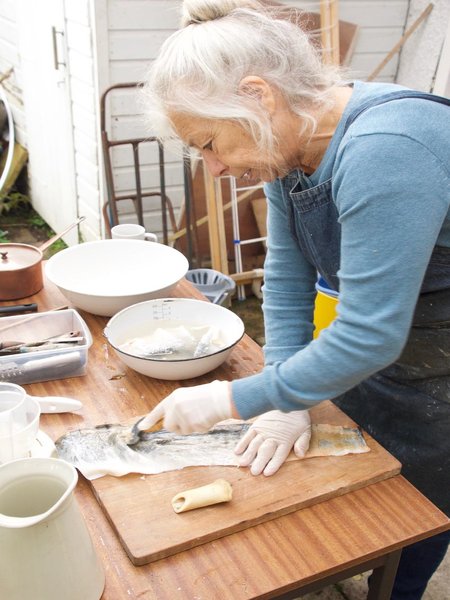
A passionate exponent of using organic materials and hand-wrought forms, piscatorial artist Kari Furre’s work has been exhibited in museums and galleries worldwide, from Norway to New York. Besides using fish leather for the new books, she has also created all kinds of art and ornaments using everything from plaice to sharkskin, while she also takes inspiration from swimming and diving in wild locations. More examples of her craft can be seen at Kari Furre - Sculptor and Metalsmith
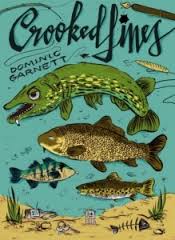
Even without the unusual cover, Crooked Lines represents a refreshingly different detour from the traditional fishing book. Featuring adventures from forgotten British Rivers to Manhattan’s Central Park and Arctic Norway, the author’s fifth book is his most daring and entertaining to date. Besides two-dozen original tales, it also includes a foreword from Matt Hayes and original illustrations, cover art and lettering from Sheffield artist Lord Bunn, who will also sign and add a special touch to each volume.
Just a handful of exclusive, individually marked collector’s editions will be available directly from the author’s website (Home - DG Fishing). Meanwhile, the standard first edition is also available at just £10 via the same site, or as an illustrated Amazon Kindle Edition at £4.99.
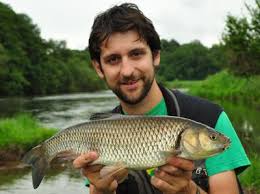
Further details/ Contact details for Enquiries & Press:
Dominic Garnett: 07804 240986 domgarnett@yahoo.co.uk
Kari Furre: Kari Furre - Sculptor and Metalsmith
CRITICAL ACCLAIM FOR CROOKED LINES:
“Irreverent, quirky and fresh. An absolute treat.” –Matt Hayes
“The Eddie Izzard of fishing.” –Neville Fickling
“Dominic has found something very special indeed. Has an immediacy fishing prose forgot it could wield.” –Idler’s Quest
“Bound to entertain any angler.” –Global Flyfisher
Picture Index:
001: Close up of specially treated fish skin leathers (L to R: cod, salmon and wolf fish).
002: Kari Furre at work in her studio in Devon, England.
003: Crooked Lines author Dominic Garnett.
It Came From the Drains - An excerpt from 'Crooked Lines'
Dom Garnett investigates some of the UK’s most random pike fishing locations, in an exclusive extract from his latest book Crooked Lines.
It’s not the most extensive pike fishing location you’ve ever seen. Nor the most scenic, to be frank. Calling it a “drain” would probably be outright flattery. The odd spatter of rain adds little to the romance of the scene before us; a muddy, reedy channel perhaps five metres across. More of a ditch than a drain you might say. Welcome to soggy Somerset.
In the trees behind I pick out the off-yellow paint of an abandoned tractor. A decrepit greenhouse and some random piping complete the picture. Had the film “Deliverance” been filmed in Somerset, this would have made a prime location. It’s so rustic here the local hoodlums have resorted to throwing hay bales into the water in the absence of shopping trolleys. Nevertheless, a simple question lingers: exactly what might be lurking in this little channel?
A little inlet pipe at the head of the drain spouts a steady trickle of water. Mid flow are signs of life at the very least, a dashing shoal of roach nosing the surface. But pike, here? It’s not exactly the River Severn. You can spy leaves on the silty bottom, no more than two feet beneath the surface.
“You’re taking the ****,” says Ian, “we may as well fish in a garden pond.” I’m about to concur when, right on cue, several little roach flip clear of the water. Am I hallucinating? Before I can pass any meaningful comment, fellow ditch hoppers Norbert Darby and Ian Nadin are launching various mutations of rubber and plastic drain bound as an argument of the “I saw it first” variety breaks out.
The first take is as about as subtle as a Glasgow kiss, a wild smash on the rod tip as Ian latches into a feisty ditch pike. Seconds later the line goes slack, the look of surprise come total disbelief still fixed on his face. The very idea of pike in this Lilliput sized water is no longer a cider-fuelled fantasy but fact.
We’re still shaking our heads as we trundle off down the drain casting as we go. But perhaps the existence of fish, including the apex predator itself, should not come as such a shock in these small, sometimes tiny, channels. Aside from the bigger and better known Somerset drains, the region is packed with countless smaller rhynes, ditches and culverts. As they criss-cross, merge and interlink, the fish inevitably also spill over into all kinds of unexpected places, the annual floods further mixing up this strange labyrinth of water and reeds, mud and fish.
Even after witnessing a pike attack you still can’t help feeling daft at times. In some reaches there is barely a foot of water and you could reach the far bank with a short leap, never mind a short cast. It goes without saying that in most cases the pike are no monsters. A real leviathan would struggle to turn round in some of these locations, although there are often plenty of rudd, frogs and other goodies to feed on. “No monsters” is quite an understatement all the same; some of the pike we witness are hardly bigger than our lures.
It is where these waters widen and join broader stretches that you can and do find more substantial pike. In our case, we get excited when we reach another drain, this time one you can’t jump across. Still plenty of cover, but a little more depth greets us. As with all fishing on the Levels though, there is no substitute for mobility. Your attitude should be simple: explore everything. It’s a task well suited to two or three leap-frogging companions. The banter also keeps you on your toes during the slower parts of the day.
Right where we meet with the bigger drain is a pikey looking spot in itself- an obvious ambush point for predators that can intercept fish traffic coming from either body of water. Like on a busy road, the junction is the place where there’s always the threat of a messy accident. Norbert quickly confirms this with a hungry jack that’s all teeth and no manners, a thin and mean looking attacker that doesn’t hesitate for a second but simply launches itself headlong at the lure from right under his feet.
Further along the bank the terrain gets increasingly confusing once again. Huge heaps of dug peat break up the flat landscape, whilst behind us is an excavated site that has developed into a flooded, overgrown haven of reeds and water. I would be tempted to call it a lake, only there’s no telling where it begins and ends, the very notion of such boundaries an alien concept in this sprawling landscape. Each of us is thinking the same thing, but the only fisher able to access this tangled little haven is the heron we can see, motionless at the far edge. I watch him jealously for a few minutes, absent-mindedly wondering whether to return some other day with a chainsaw.
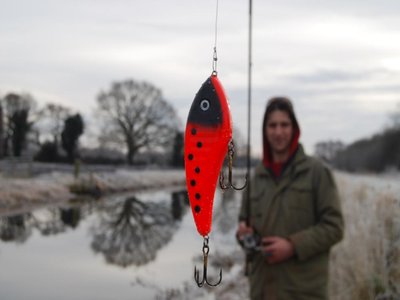
The drain begins to tow in the midday sun. The peat stained water turns muddier and with bites scarce we swap and switch our lures. My own preference is for something bright and bold. Sometimes, I reason, the pike need not so much an easy meal as a great big neon sign that reads “eat here!”. A rattling, orange jerkbait cuts a fine dash through the murk, gliding and swooping left to right. I flip out a short cast to some rushes. Nothing happens. The next twenty casts nothing happens either. In fact, it is only half an hour later as I’m wondering what could possibly mistake this spotted orange oddity for a meal that I get the shock of my life. From beneath a gallery of dying reed stems, out slides a solid, mottled flank. Jaws flair and the jerkbait disappears in an almighty slash. The pike feels the tension and plunges toward the deep middle of the drain, the reel clutch buzzing in discomfort. The fight is a gripping if short lived affair. As Ian reaches me with the net she gives a titanic shake of the head, attempting to wallow under the bank. I hold firm and she comes up to the surface, a classic drain pike: long and lean, emerald and peat stained gold. The jerkbait is still hidden from view, lost somewhere in the toothy hollow of a cavernous, oversized head. Thankfully the hooks are debarbed and after a brief encounter with some forceps I’m holding the fish back in the water. She can’t be much bigger than eight or nine pounds, but for such a small drain this is an epic monster.
A few other arguments ensue with these backwater pike, enough at least to keep a trio of restless anglers excited on a cool afternoon. More detours are taken. More reeds and muddy miles; more bad directions and places not on the map. The day is full of surprises, some less savoury than others. In a network of water that could have been devised by a mad scientist, water levels rise and fall unpredictably from day to day, depositing all kinds of strange debris on this exposed landscape. Today’s treasures include a VHS video cassette, assorted car parts and a single hotdog sausage in a jar.
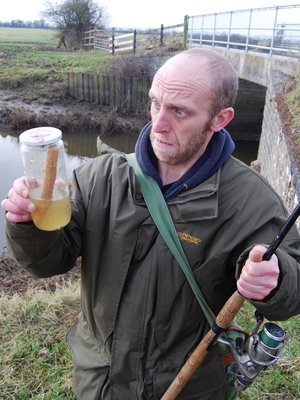
“Which drain is this?” asks Norbert at one point. I shrug my shoulders. With the light starting to go it is high time to return to the world we came from, where things are better mapped but less exciting, cleaner and more predictable. If we stay much longer, we may never find our way back. “We really should get going,” warns Ian. I nod my head, before making yet another “last” cast.
Great reading and ideal gifts for anglers: Crooked Lines and Tangles with Pike
Packed with entertaining tales, anarchic humour and beautiful photography, Dom Garnett’s critically acclaimed book Crooked Lines makes fantastic reading for any angler. Featuring compelling adventures from Britain’s forgotten rivers to Manhattan and Arctic Norway, it also features original artwork from Sheffield artist Lord Bunn and a foreword by Matt Hayes. Order it from the author’s website www.dgfishing.co.uk at just £9.99, or as an Amazon Kindle Edition for £4.99
Meanwhile, Tangles with Pike represents a decade of the author’s finest work on predator fishing, along with new and previously unpublished material. The collection contains many great tales and original articles to inspire your pike fishing this winter. It is also available from Dom’s site www.dgfishing.co.uk for £14.99 in signed hardback. Or you can buy it along with Crooked Lines at the special deal of just £20 plus postage. Perfect Christmas gifts for anglers!

Dominic Garnett’s collection of fishing tales Crooked Lines is set for a truly eye-opening collector’s edition this winter, in a special collaboration with Devon artist Kari Furre.
While collectible books come in many guises, you would be hard pushed to find a stranger or more beautiful volume than the new edition of Crooked Lines. Eschewing conventional cover materials for real fish skin, a small run of books will offer something spectacularly different, scales and all.
Each individual collectible edition will be a one-off, hand-made work of art, created using a painstaking combination of tools and processes from centuries-old curing methods to modern book-binding techniques. The first covers have been fashioned from natural and dyed Icelandic salmon skin, but further versions will use other fish species including cod and even a wolf-fish edition.All the skins come from sustainable sources, essentially up-cycling a material that is usually discarded.
“The new editions have involved a stroke of luck but also a lot of hard work,” explains the author, “because while fish leather is beautiful and surprisingly durable, working with the material takes rare skill and weeks of careful work. Kari is one of only a tiny handful of specialists worldwide, so I was incredibly lucky to find her here in Devon, on the banks of the River Dart.”

A passionate exponent of using organic materials and hand-wrought forms, piscatorial artist Kari Furre’s work has been exhibited in museums and galleries worldwide, from Norway to New York. Besides using fish leather for the new books, she has also created all kinds of art and ornaments using everything from plaice to sharkskin, while she also takes inspiration from swimming and diving in wild locations. More examples of her craft can be seen at Kari Furre - Sculptor and Metalsmith

Even without the unusual cover, Crooked Lines represents a refreshingly different detour from the traditional fishing book. Featuring adventures from forgotten British Rivers to Manhattan’s Central Park and Arctic Norway, the author’s fifth book is his most daring and entertaining to date. Besides two-dozen original tales, it also includes a foreword from Matt Hayes and original illustrations, cover art and lettering from Sheffield artist Lord Bunn, who will also sign and add a special touch to each volume.
Just a handful of exclusive, individually marked collector’s editions will be available directly from the author’s website (Home - DG Fishing). Meanwhile, the standard first edition is also available at just £10 via the same site, or as an illustrated Amazon Kindle Edition at £4.99.

Further details/ Contact details for Enquiries & Press:
Dominic Garnett: 07804 240986 domgarnett@yahoo.co.uk
Kari Furre: Kari Furre - Sculptor and Metalsmith
CRITICAL ACCLAIM FOR CROOKED LINES:
“Irreverent, quirky and fresh. An absolute treat.” –Matt Hayes
“The Eddie Izzard of fishing.” –Neville Fickling
“Dominic has found something very special indeed. Has an immediacy fishing prose forgot it could wield.” –Idler’s Quest
“Bound to entertain any angler.” –Global Flyfisher
Picture Index:
001: Close up of specially treated fish skin leathers (L to R: cod, salmon and wolf fish).
002: Kari Furre at work in her studio in Devon, England.
003: Crooked Lines author Dominic Garnett.
It Came From the Drains - An excerpt from 'Crooked Lines'
Dom Garnett investigates some of the UK’s most random pike fishing locations, in an exclusive extract from his latest book Crooked Lines.
It’s not the most extensive pike fishing location you’ve ever seen. Nor the most scenic, to be frank. Calling it a “drain” would probably be outright flattery. The odd spatter of rain adds little to the romance of the scene before us; a muddy, reedy channel perhaps five metres across. More of a ditch than a drain you might say. Welcome to soggy Somerset.
In the trees behind I pick out the off-yellow paint of an abandoned tractor. A decrepit greenhouse and some random piping complete the picture. Had the film “Deliverance” been filmed in Somerset, this would have made a prime location. It’s so rustic here the local hoodlums have resorted to throwing hay bales into the water in the absence of shopping trolleys. Nevertheless, a simple question lingers: exactly what might be lurking in this little channel?
A little inlet pipe at the head of the drain spouts a steady trickle of water. Mid flow are signs of life at the very least, a dashing shoal of roach nosing the surface. But pike, here? It’s not exactly the River Severn. You can spy leaves on the silty bottom, no more than two feet beneath the surface.
“You’re taking the ****,” says Ian, “we may as well fish in a garden pond.” I’m about to concur when, right on cue, several little roach flip clear of the water. Am I hallucinating? Before I can pass any meaningful comment, fellow ditch hoppers Norbert Darby and Ian Nadin are launching various mutations of rubber and plastic drain bound as an argument of the “I saw it first” variety breaks out.
The first take is as about as subtle as a Glasgow kiss, a wild smash on the rod tip as Ian latches into a feisty ditch pike. Seconds later the line goes slack, the look of surprise come total disbelief still fixed on his face. The very idea of pike in this Lilliput sized water is no longer a cider-fuelled fantasy but fact.
We’re still shaking our heads as we trundle off down the drain casting as we go. But perhaps the existence of fish, including the apex predator itself, should not come as such a shock in these small, sometimes tiny, channels. Aside from the bigger and better known Somerset drains, the region is packed with countless smaller rhynes, ditches and culverts. As they criss-cross, merge and interlink, the fish inevitably also spill over into all kinds of unexpected places, the annual floods further mixing up this strange labyrinth of water and reeds, mud and fish.
Even after witnessing a pike attack you still can’t help feeling daft at times. In some reaches there is barely a foot of water and you could reach the far bank with a short leap, never mind a short cast. It goes without saying that in most cases the pike are no monsters. A real leviathan would struggle to turn round in some of these locations, although there are often plenty of rudd, frogs and other goodies to feed on. “No monsters” is quite an understatement all the same; some of the pike we witness are hardly bigger than our lures.
It is where these waters widen and join broader stretches that you can and do find more substantial pike. In our case, we get excited when we reach another drain, this time one you can’t jump across. Still plenty of cover, but a little more depth greets us. As with all fishing on the Levels though, there is no substitute for mobility. Your attitude should be simple: explore everything. It’s a task well suited to two or three leap-frogging companions. The banter also keeps you on your toes during the slower parts of the day.
Right where we meet with the bigger drain is a pikey looking spot in itself- an obvious ambush point for predators that can intercept fish traffic coming from either body of water. Like on a busy road, the junction is the place where there’s always the threat of a messy accident. Norbert quickly confirms this with a hungry jack that’s all teeth and no manners, a thin and mean looking attacker that doesn’t hesitate for a second but simply launches itself headlong at the lure from right under his feet.
Further along the bank the terrain gets increasingly confusing once again. Huge heaps of dug peat break up the flat landscape, whilst behind us is an excavated site that has developed into a flooded, overgrown haven of reeds and water. I would be tempted to call it a lake, only there’s no telling where it begins and ends, the very notion of such boundaries an alien concept in this sprawling landscape. Each of us is thinking the same thing, but the only fisher able to access this tangled little haven is the heron we can see, motionless at the far edge. I watch him jealously for a few minutes, absent-mindedly wondering whether to return some other day with a chainsaw.

The drain begins to tow in the midday sun. The peat stained water turns muddier and with bites scarce we swap and switch our lures. My own preference is for something bright and bold. Sometimes, I reason, the pike need not so much an easy meal as a great big neon sign that reads “eat here!”. A rattling, orange jerkbait cuts a fine dash through the murk, gliding and swooping left to right. I flip out a short cast to some rushes. Nothing happens. The next twenty casts nothing happens either. In fact, it is only half an hour later as I’m wondering what could possibly mistake this spotted orange oddity for a meal that I get the shock of my life. From beneath a gallery of dying reed stems, out slides a solid, mottled flank. Jaws flair and the jerkbait disappears in an almighty slash. The pike feels the tension and plunges toward the deep middle of the drain, the reel clutch buzzing in discomfort. The fight is a gripping if short lived affair. As Ian reaches me with the net she gives a titanic shake of the head, attempting to wallow under the bank. I hold firm and she comes up to the surface, a classic drain pike: long and lean, emerald and peat stained gold. The jerkbait is still hidden from view, lost somewhere in the toothy hollow of a cavernous, oversized head. Thankfully the hooks are debarbed and after a brief encounter with some forceps I’m holding the fish back in the water. She can’t be much bigger than eight or nine pounds, but for such a small drain this is an epic monster.
A few other arguments ensue with these backwater pike, enough at least to keep a trio of restless anglers excited on a cool afternoon. More detours are taken. More reeds and muddy miles; more bad directions and places not on the map. The day is full of surprises, some less savoury than others. In a network of water that could have been devised by a mad scientist, water levels rise and fall unpredictably from day to day, depositing all kinds of strange debris on this exposed landscape. Today’s treasures include a VHS video cassette, assorted car parts and a single hotdog sausage in a jar.

“Which drain is this?” asks Norbert at one point. I shrug my shoulders. With the light starting to go it is high time to return to the world we came from, where things are better mapped but less exciting, cleaner and more predictable. If we stay much longer, we may never find our way back. “We really should get going,” warns Ian. I nod my head, before making yet another “last” cast.
Great reading and ideal gifts for anglers: Crooked Lines and Tangles with Pike
Packed with entertaining tales, anarchic humour and beautiful photography, Dom Garnett’s critically acclaimed book Crooked Lines makes fantastic reading for any angler. Featuring compelling adventures from Britain’s forgotten rivers to Manhattan and Arctic Norway, it also features original artwork from Sheffield artist Lord Bunn and a foreword by Matt Hayes. Order it from the author’s website www.dgfishing.co.uk at just £9.99, or as an Amazon Kindle Edition for £4.99
Meanwhile, Tangles with Pike represents a decade of the author’s finest work on predator fishing, along with new and previously unpublished material. The collection contains many great tales and original articles to inspire your pike fishing this winter. It is also available from Dom’s site www.dgfishing.co.uk for £14.99 in signed hardback. Or you can buy it along with Crooked Lines at the special deal of just £20 plus postage. Perfect Christmas gifts for anglers!
